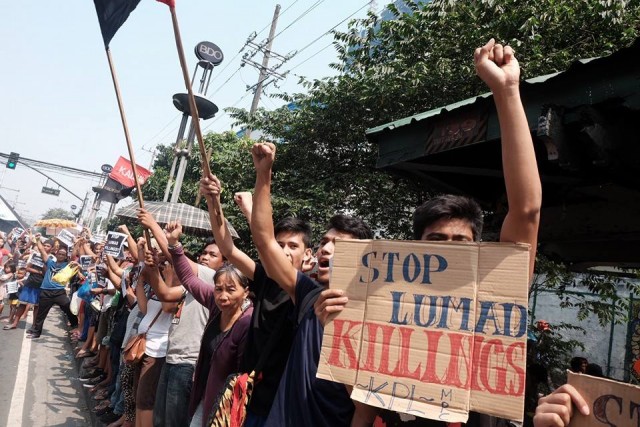1. Introduction:
The Universal Declaration of Human Rights (UDHR) ensures universal and effective recognition and observance of human rights set out in the declaration. The major purpose behind the UDHR is the provision of justice to all human beings without any discrimination. The human rights discipline has given more meaning and normative content to the concept of access to justice. Indigenous people are prone to exploitation and discrimination and the United Nations Declaration on the Rights of Indigenous Peoples (UNDRIP)[1] was a serious effort to counter this exploitation. While not being formally binding as a matter of international law, it has considerable legal and political force.
Indigenous Peoples (IP) are those who inhabited a land before it was colonized by people from other societies and who consider themselves distinct from the societies currently governing their territories[2]. They are present in some 70 countries and make up almost 5 per cent of the world’s total population. They face lack of political representation and participation, economic marginalization, poverty, lack of access to social services, and discrimination[3]. Despite representing a small percentage of humans on earth, they nevertheless make up one-third of the world’s extremely poor rural people.
Indigenous Peoples face difficulties in having gaining criminal justice and continue to face discrimination and inequalities in this context. They are often victims of crimes and are more likely to be charged with offences.[4] Moreover, they tend to inhabit geographical regions most impacted or threatened by climate change amongst hence they are amongst the world’s most exposed and vulnerable people to global warming and climate change.
International law contains mechanism to ensure justice to Indigenous Peoples. Institutions focused on human rights have strived to ensure provision of rights to them since the 1970s. The issue of injustice against IP came to the forefront in labor markets. The international human rights framework later ensured that IP sought and obtained recognition of their rights to self-determination, lands, territories and resources, non-discrimination in criminal justice system and other constructive agreements with states.
The purpose of this research paper is to shed light on the problems being faced by IP and how they can be remedied. This study is significant because it will reduce a noteworthy gap in knowledge about the problems being faced by the IP. It will evaluate the criminal justice systems of various countries in which IP exist and will focus on the shortcomings of the criminal justice systems of such countries and on ways to overcome them. It will also focus on the problems the IP face due to the deteriorating environment and the role they can play in countering this phenomenon.
The present study answers the following questions. Are there any international conventions dealing specifically with protection of the rights of Indigenous Peoples and to what extent have they addressed the problem of discrimination and exploitation of IP? How can the states ensure non-discrimination against IP in their criminal justice system after doing case by case study? How has global warming impacted the lives of IP and what are the remedies to ensure protection of IP from the effects of climate change?
2. International instruments for the protection of indigenous peoples’ human rights:
As defined by the UN Special Rapporteur to the Sub-commission on Prevention of Discrimination and Protection of Minorities, Indigenous Peoples are “those which having a historical continuity with pre-invasion and pre-colonial societies that developed on their territories, consider themselves distinct from other sectors of societies now prevailing in those territories, or parts of them. They form at present non-dominant sectors of society and are determined to preserve, develop, and transmit to future generations their ancestral territories, and their ethnic identity, as the basis of their continued existence as peoples, in accordance with their own cultural patterns, social institutions and legal systems.” (Martinez-Cobo, 1984)
Indigenous Peoples are found in almost all continents. They are very sensitive about their culture and traditions and are considered to be very close to nature. Several international instruments protect the rights of IP. IP rights overlap with many other human rights provided in international agreements. Many essential rights of IPs are not framed in specific treaties for Indigenous Peoples but are part of more general treaties like UDHR or the Convention on the Prevention and Punishment of the Crime of Genocide. The UNDRIP, which shall be discussed later, is one of the fundamental documents dealing exclusively with the rights of IPs. However, several other conventions also protect the rights of IPs indirectly. Some of them are discussed below:
2.1 Instruments dealing indirectly with the rights of Indigenous Peoples:
a. Universal Declaration of Human Rights:
UDHR provides equal rights to all human beings without any discrimination. Article 1 and Article 2 of the charter ensures this; hence it provides protection to IPs.
b. International Covenant on Civil and Political Rights (1966)[5]:
Article 27 of the ICCPR provides freedom to minorities to enjoy their own culture, to profess and practice their religions and to use their own language. This article can be extended to grant protection to IPs throughout the world.
c. International Covenant on Economic, Social and Cultural Rights (1966)[6]:
This Covenant describes the basic economic, social, and cultural rights of individuals. It also includes provisions for collective rights.
d. Convention on the Elimination of All Forms of Racial Discrimination (1966)[7]:
This convention prohibits discrimination against any ethnic community on the basis of race. It can be extended to provide protection to IPs.
2.2 The united nations declaration on the rights of indigenous peoples (UNDRIP):
The United Nations Declaration on the Rights of Indigenous Peoples provides a normative framework for the development and implementation of bi-lateral mechanisms for access to justice, conflict resolution and redress of Treaty violations with full and equal participation of both the state and Indigenous Nation Treaty partners. The Declaration consists of 46 Articles and is an extensive document ensuring the protection of rights of IPs and provides a mechanism for the provision of justice to Indigenous Peoples. Some of the important articles dealing primarily with criminal and climate justice for the Indigenous Peoples are as follows:
Article 26
- “Indigenous peoples have the right to the lands, territories and resources which they have traditionally owned, occupied or otherwise used or acquired.
- Indigenous peoples have the right to own, use, develop and control the lands, territories and resources that they possess by reason of traditional ownership or other traditional occupation or use, as well as those which they have otherwise acquired.
- States shall give legal recognition and protection to these lands, territories and resources. Such recognition shall be conducted with due respect to the customs, traditions and land tenure systems of the indigenous peoples concerned”.[8]
Article 26 of the UNDRIP ensures the protection of environmental rights of indigenous people. IPs are very close to nature. The extraction of natural resources at a quick pace and the phenomenon of climate change has made IPs vulnerable to threats emerging as a result of this phenomenon. This Article compels a state to grant legal protection to the lands and resources utilized by the IPs.
Article 27
“States shall establish and implement, in conjunction with indigenous peoples concerned, a fair, independent, impartial, open and transparent process, giving due recognition to indigenous peoples’ laws, traditions, customs and land tenure systems, to recognize and adjudicate the rights of indigenous peoples pertaining to their lands, territories and resources, including those which were traditionally owned or otherwise occupied or used. Indigenous peoples shall have the right to participate in this process”.
Indigenous Peoples give great importance to their customs and traditions. This article ensures that states recognize and formulate laws in consultation with the IPs to protect their culture and resources.
Article 3, Article 18 and Article 37 of UNDRIP in particular and some other articles in general provide a principled, right-based, but as yet unimplemented, normative framework for access to justice based on the internationally recognized minimum standards for such processes.
The 46 Articles of UNDRIP have addressed almost all the issues being faced by indigenous people throughout the world. This declaration is a serious effort on part of international human rights bodies and states to guarantee safeguards for the IPs. It provides “minimum standards” of protection to IPs spread throughout various regions of the world.
2.3 Instruments dealing exclusively with the rights of Indigenous Peoples:
a. UN Working Group on Indigenous Populations[9]:
This body reviews the development concerning the promotion and protection of Indigenous Peoples human rights and develops international standards for IPs human rights and freedom.
b. UN Permanent forum on Indigenous Issues[10]:
This is the first and only international body in the UN that has Indigenous Persons as members. It meets once a year for ten working days and submits annual reports to the Economic and Social Council. It works on issues related to economic and social development of IPs.
c. UN Working Group on the Draft Declaration on the Rights of Indigenous Peoples[11]:
This Working Group of the Commission on Human Rights meets once a year and is responsible for reviewing and debating the Draft Declaration. The Declaration is non-binding for states, however, it will serve as a powerful statement of universally accepted norms as it will be adopted by consensus of all member states of the UN and will provide a strong basis for arguing for greater legal protection for indigenous rights in many countries.
d. UN Special Rapporteur on the situation of the human rights and fundamental freedoms of Indigenous Peoples[12]:
The mandate of the Special Rapporteur on IPs is to gather information on the violation of human rights and fundamental freedom of IPs, to formulate recommendations to prevent and remedy such violations and to work together with other experts on UN Commission on Human Rights.
3. Access To Justice To Indigenous People
Indigenous Peoples and the criminal justice system:
3.1 Australia: The Aboriginal and Torres Strait Islanders;
The Aboriginal and Torres Strait Islander Peoples of Australia comprise the oldest living cultures in the world. The Aboriginal peoples of Australia feel discriminated due to the current criminal justice system formulated on western principles. This system was formulated without consultation of the IPs of Australia.[13] Aboriginals are more likely to be victims of offence and are also more likely to be charged with offences which entail harsher punishments with lesser chance of receiving bail. A national census held in Australia provided alarming figures of over representation of Aboriginal people in the criminal justice system of Australia. Aboriginal and Torres Strait Islander adults are incarcerated at 15 times the rate of non-indigenous adults. Moreover, the imprisonment rate for Aboriginal and Torres Strait Islander women has grown by 58.6 percent between the years 2000 to 2010, and it has grown by 35.2 percent for Aboriginal and Torres Strait Islander men.[14]
Overrepresentation of Aboriginals and Torres Strait Islanders in the justice system is the result of a complex interplay of historical and contemporary factors. At present, there is no agreement between the government of Australia and Aboriginal and Torres Island peoples to deal with this problem. The absence of an effective national strategy or commitment defies the fact that there is a significant gap between the level of exposure and nature of interaction of Aboriginal and Torres Strait Islander peoples.
In order to ensure access to justice for Aboriginal and Torres Strait Islander peoples, an effective strategy must be formulated. This includes a constitutional reform in Australian laws that recognizes the unique place of Aboriginal and Torres Strait Islander peoples to end discrimination against them. Relationships based on principles of justice, democracy, respect for human rights, non-discrimination and good faith must be established between the state and the IPs. The government must facilitate access to justice as well as political, social, cultural and economic development.
3.2 Maori and the criminal justice system in New Zealand:
Like Australia, New Zealand was also colonized by white settlers specifically from Britain. The English legal system was adopted by the settlers who neglected the cultural norms of Maori. This paved way for the marginalization of Maori. The Law Commission of New Zealand acknowledged that Maori are overrepresented in court proceedings and are more likely to be incarcerated than the European settlers. There is a realization in New Zealand legislative circles to address this issue of over representation of Maori in criminal justice system and various programs have been launched by the Department of Correction to address this problem.
Despite these initiatives the statistics reveal that the Criminal Justice System in New Zealand has failed to deliver meaningful results in addressing the issues of IPs. A famous jurist, Justice Heath opines that two options must be considered. First, that the Maori custom should be incorporated as part of the common law and second that where both parties are Maori, their custom should be chosen as the method of resolving disputes.[15] This can be done by over-hauling the justice system or the development of a new system of adjudication based entirely on the Maori customs to adjudicate matters involving Maoris only.[16]
The Maori must be given the right to self-determination in order to enable them to provide their inputs to resolve the issue of overrepresentation in criminal justice system. This is essential because the inclusion of IPs as decision makers will help in achieving this endeavor.[17] The thrust of self-determination is to grant the IPs the right to be in control of their destinies and to create their own political and legal organizations.
3.3 Indigenous Peoples and access to justice in Africa:
Traditional hunter-gatherers Batwa, residing in Uganda, Rwanda, Burundi and the Democratic Republic of the Congo are some of the most widely recognized and most marginalized IPs in Africa. Ogiek, Sengwer, Maasai, Turkana, Samburu, Endorois and Imazighen are some other traditional hunter-gatherer communities that self-identify as Indigenous Peoples.[18]
Like other minorities around the globe, IPs in Africa are prone to discrimination and exploitation. In stark contrast to Australia and New Zealand where the courts have authority, the African states have often refused to be bound by the declarations of their own courts. This has exacerbated the problems of IPs across the African continent. The failure of African states to protect the rights of IPs has compelled them to seek justice from other forums. The African regional human rights system, including the African Commission on Human and Peoples’ Rights and the African Court, has taken concrete steps to recognize and protect the unique and collective rights of IPs. The main African human rights treaty is the African Charter on Human and Peoples’ Rights or the African Charter.[19] The African Charter is one of the most comprehensive instruments of civil-political, socio-economic and peoples’ rights; it has granted plausible protection to IPs.
In Africa, various frameworks and bodies have been established to provide protection to Indigenous Peoples. However, access to justice remains a substantial challenge for the Indigenous Peoples. The lack of interest from the African states have increased the vulnerability of the IPs in Africa. Africa as a whole is marred with political instability, poverty, disease, and wars. In this scenario, the plight of IPs has gone from bad to worst. Only a sincere effort by African states and the international bodies can bring relief to these downtrodden peoples.
3.4 Indigenous Peoples and access to justice in Canada:
The indigenous people in Canada face many legal problems. The ratio of Canadian IP incarceration as per their population is much higher than the ratio of settlers in jails. Between 2005 and 2015, the Indigenous inmate population grew by 50 percent to the overall growth rate of 10 percent. Indigenous women comprise 37 percent of all women serving a sentence of more than two years and the incarceration rates of Indigenous people in some parts of Canada are up to 33 times higher than for non-indigenous peoples.[20] The Marshall Commission of Canada suggested that excessive involvement of the Aboriginal people with the criminal justice system is a result of the disastrous socio-economic situation faced by them.[21]
This trend can be curbed by ensuring meaningful participation and equitable treatment for IPs in the justice system.at present, the Aboriginals have absolutely no say in the current justice system of Canada. The solution to this discrimination is to encourage the IPs to participate in the system by defining the meaning, institutions and standards of justice in their own communities. The Aboriginal criminal justice must incorporate those principles and rules which are understood by them and not only those which are conceptualized by the non-aboriginal Canadians.
3.5 Indigenous people and access to justice in USA:
One of the major problems being faced by Native Americans in the USA is that they are typically prosecuted under federal law for serious offences committed on reservations instead of state laws in which punishment for the same offences is much lighter.[22] Like other nations where IPs live, the Native Americans in the USA are overrepresented in the criminal justice system of the USA. In the past five years, the ratio of Native Americans in the US prisons has increased by 27 percent. In South Dakota, the state with the fourth highest percentage of Native American residents, the IPs compose only 8.5 percent of the total population but compose almost 60 per cent of the federal caseload. This trend is also visible in other states where Native Americans live.
The few figures stated above indicate the existence of a gap in the US justice system which if not addressed might lead to alienation of the Natives in the USA. This trend can be arrested by ensuring equal participation of Native Americans in the lawmaking process in the US. The IPs must be given equal participation in the lawmaking process to ensure the formulation of a justice system compatible with their own customs and traditions.
3.6 Access to justice for Indigenous Peoples in Latin America:
Throughout South America, the justice system is marred with several weaknesses which are exploited by criminals and states alike. Access to justice for people living in rural areas is highly limited. The rural IPs living in South America are vulnerable to discrimination and injustice. It is even more so for indigenous women who are generally the most excluded, marginalized and unrepresented of all. Large portions of population in Bolivia, Peru and Ecuador consider themselves to be IPs. In recent years, these IPs have obtained a stronger impact on national politics.[23]
All these countries have made laws to bring the IPs into main stream since they are multi-ethnic and multi-cultural. The Bolivian government has codified human rights, draft declarations and specific legislation to recognize the rights of IPs especially the women. In Ecuador, the new constitution adopted in 2008 ensures the protection of rights of almost 13 recognized indigenous communities living in the country. These steps taken by these two countries, however, are not enough to end the dismal conditions of the IPs.
Guatemala is another Latin American country which is home to several IPs including the K’iche, Q’eqchu, Kaqchikel, and Mamm-speaking Mayans who constitute almost 40 percent of the total population of the country numbering well over 5 million.[24] The Guatemala Constitution provides protection to IPs through Article 66 which ensures protection of Indigenous ways of life, customs, traditions, social organizations, and languages.[25] Despite the protection provided to IPs under the constitution, they remain one of the most exploited sections of the society. The IPs constitute almost 73 percent of the total population living below poverty line in that country. They are also underrepresented in government posts.
The civil war in Guatemala which ended in 1996 after a Peace Accord led to the massacre and rapes of thousands of IPs in the country. Several high government officials were convicted of war crimes and crimes against humanity. Since the end of the civil war, Guatemala has invited several UN experts to provide recommendations to improve the conditions of the IPs in the country. Moreover, the Guatemalan government has made several legislative changes to ensure equal representation of the IPs in the government. These steps cannot be expected to bring revolutionary changes in the daily lives of IPs but they will indeed pave way for amelioration of their condition.
4. Environmental justice for indigenous peoples:
Indigenous Peoples have been coevolving with environmental changes over the centuries. They have adopted sustainable adaptive lifeways. They possess knowledge of their environment. Indigenous Peoples are prototypical environmentalists living harmoniously with nature. This close attachment to land and the environment is often described as the defining characteristic of IP. A report published by UN titled “Our Common Future” proclaimed that, “the IPs are the repositories of vast accumulations of the traditional knowledge and experience and larger society could learn a great deal from their traditional skills in sustainably managing very complex ecological systems”.[26]
Climate change has adversely affected the lives of IPs. The international community must not only find ways to control climate change but should also take input from the IPs to move towards sustainable development and make use of the intelligence, knowledge and diversity of indigenous approaches and actions. This will help in improving our strategies to counter global warming and to ensure that such actions support the cultural persistence and the rights of self-determination of IPs.
IPs tend to exist in geographically marginal places. It is evident from the fact that the IPs throughout the world own only a fraction of land which they previously owned. These marginal lands inhabited by the IP are often disproportionally affected by climate change. The drought-prone lands and the rapidly rising levels of water due to melting of ice in the Arctic region has started impacting many indigenous tribes throughout the world. The tendency of the IPs to depend more directly on their land and its natural resources of those lands has increased their vulnerability to climate change.
To exacerbate the problems of IPs, the international community ignores them in formulation of policies to tackle the phenomenon of global warming and climate change. This marginalization of IPs from such discussions is an environmental injustice to IPs and can be stopped by taking onboard the Indigenous leaders in discussions relating to environment. This will have several advantages. A significant gap exists in the understanding of how climate change plays out at local levels. IPs present empirical information which is exclusively available to them only and should be utilized by global policymakers to improve the understanding of climate change at local scales. However, IPs have been neglected and environmental injustice against them continues to prevail.
This environmental injustice with IPs often results in tensions between them and the state authorities. For instance, the Clayqout Sound movement initiated in Canada, widely touted by the environmentalists as a successful conservation initiative to protect the pristine old growth forests of British Columbia totally ignored the Indigenous tribes in the area. The groups involved in the campaign produced a narrative that reinforced colonial ideologies of nature by ignoring the core concerns of indigenous tribes. Hence, no significant headway was made in achieving the end of clean environment.
Another example of this kind of injustice is the Dakota pipeline protests which began in early 2016 in reaction to the approved construction of a pipeline passing through the localities of Native Americans living in the northern parts of the USA[27]. The pipeline is supposed to pass beneath the Missouri and Mississippi rivers as well as under a part of Lake Oahe. The Indian tribes consider the pipeline a threat to the regions clean water and to ancient burial grounds. These protests resulted in violent clashes between the police and the protestors resulting in several injuries.
To end environmental injustice against the IPs, several steps need to be taken. First and foremost is the representation of IPs at international conferences relating to climate change. IPs must be given full membership at the UNFCC negotiations which would decrease their isolation and would enable them to provide their inputs for sustainable development.
Secondly, the IPs must be acknowledged as experts in the knowledge of sustainable development and must be given increased role in the formulation of environment-friendly policies. Their experience and environmental knowledge is crucial to developing an understanding of climate change and adaption solutions. Finally, it is imperative that a culture of respect for IP rights, livelihood, and resilience in adapting to environmental change be promoted across all levels of society.
5. Conclusion:
Indigenous Peoples are among the most vulnerable and suppressed communities of the world. They face various socio-economic issues and are overrepresented in criminal justice systems throughout the world. They are often victims of crime and once accused of an offence are more likely to be charged. The Aboriginals and Torres Strait Islanders in Australia and the Maori in New Zealand face discrimination in the respective criminal justice systems. Both these states have taken several steps to safeguard the rights of IP but these aren’t enough. The plight of millions of IP in Africa and Americas is not different. The IP also face environmental injustice. Being close to nature and possessing valuable knowledge about sustainable development, they are major stakeholders in decisions regarding environment. However, they have been ignored and are not taken onboard. International organizations and states must take concrete steps to provide protection to the IPs. Mere existence of several international instruments for the protection of IP is not enough to guarantee protection of one of the most vulnerable communities in the world.
Reference
[1] GA Res 61/295, A/Res/61/295 (2007).
[2] “The Rights of Indigenous Peoples.” Human Rights Library- University of Minnesota. Accessed February 3, 2017. http://hrlibrary.umn.edu/edumat/studyguides/indigenous.html.
[3] Welcome to the United Nations. Accessed February 3, 2017. http://www.un.org/esa/socdev/unpfii/documents/5session_factsheet1.pdf.
[5] “International Covenant on Civil and Political Rights.” Accessed February 4, 2017. http://www.ohchr.org/EN/ProfessionalInterest/Pages/CCPR.aspx.
[6] “International Covenant on Economic, Social and Cultural Rights.” Accessed February 4, 2017. http://www.ohchr.org/EN/ProfessionalInterest/Pages/CESCR.aspx.
[7][7] “International Convention on the Elimination of All Forms of Racial Discrimination.” Accessed February 4, 2017. http://www.ohchr.org/EN/ProfessionalInterest/Pages/CERD.aspx.
[8] Welcome to the United Nations. Accessed February 3, 2017. http://www.un.org/esa/socdev/unpfii/documents/DRIPS_en.pdf.
[9] “Working Group on Indigenous Populations.” Accessed February 4, 2017. http://www.ohchr.org/EN/Issues/IPeoples/Pages/WGIP.aspx.
[10] “United Nations For Indigenous Peoples.” Welcome to the United Nations. Accessed February 4, 2017. https://www.un.org/development/desa/indigenouspeoples/.
[11] “Working Group on the Draft Declaration on the Rights of Indigenous Peoples.” Accessed February 4, 2017. http://www.ohchr.org/EN/Issues/IPeoples/Pages/WGDraftDeclaration.aspx.
[12] “Special Rapporteur on the Rights of Indigenous Peoples.” Accessed February 4, 2017. http://www.ohchr.org/EN/Issues/IPeoples/SRIndigenousPeoples/Pages/SRIPeoplesIndex.aspx.
[13] United Nations Declaration on the Rights of Indigenous Peoples, 13 September 2007, GA Res. 61/295 (Annex), UN GAOR, 61st Sess., Supp. No. 49, Vol. III, UN Doc. A/61/49, article 19
[14] Australian Institute of Health and Welfare, Juvenile Justice in Australian 2010– 11, Juvenile Justice Series no. 10, (Canberra: AIHW 2011) Cat No JUV 10, p. 7
[15] Heath, P., One law for all – Problems in applying Maori custom law in a Unitary State (2010–2011) Vols 13–14 Yearbook of New Zealand Jurisprudence. p. 197.
[16] Heath, ibid, p. 199.
[17] “The Rights of Indigenous Peoples Under International Law and Their Domestic Relevance in Aotearoa/New Zealand by Claire Charters :: SSRN.” Search ELibrary :: SSRN. Accessed February 3, 2017. https://papers.ssrn.com/sol3/papers.cfm?abstract_id=2887664.
[18] MO Makoloo, Kenya: Minorities, Indigenous Peoples and Ethnic Diversity. London: Minority Rights Group International, 2005, http://www.minorityrights. org/download.php?id=147.
[19] 0 African Charter on Human and Peoples’ Rights, OAU Doc. CAB/LEG/67/3 rev. 5, 21 I.L.M. 58 (1982), entered into force 21 October 1986.
[20] “Indigenous People Overrepresented in Justice System a ‘sad Reality’: Jody Wilson-Raybould – Politics.” CBC News. Accessed February 4, 2017. http://www.cbc.ca/news/politics/indigenous-people-overrepresented-justice-system-sad-reality-1.3718064.
[21] 404 Not Found. Accessed February 4, 2017. https://static1.squarespace.com/static/511bd4e0e4b0cecdc77b114b/t/54aafc38e4b0d05e1ab70204/1420491832820/FINAL+-+ATJ_Aboriginal_2013_Research_Materials.pdf.
[22] “Native Americans Are the Unseen Victims of a Broken US Justice System — Quartz.” Quartz. Accessed February 4, 2017. https://qz.com/392342/native-americans-are-the-unseen-victims-of-a-broken-us-justice-system/.
[23] Effectius ASBL – Home. Accessed February 4, 2017. http://effectius.com/yahoo_site_admin/assets/docs/Access_to_justice_perspectives_for_indigenous_communities_in_Ecuador_and_Bolivia_MVDV_Newsletter8.27185913.pdf.
[24] 5 Secretaría de Planificación y Programación de la Presidencia, Guatemala un país pluricultural. http://www.segeplan.gob.gt/index2. php?option=com_content&do_pdf=1&id=85.
[25] República de Guatemala, Constitución de 1985 con las reformas de 1993 (2011) Base de Datos Políticos de las Americas. http://pdba.georgetown.edu/ Constitutions/Guate/guate93.html
[26] World Commission on Environment and Development, Our Common Future (Oxford University Press, 1987) 114-15.
[27] “Dakota Pipeline Protests.” NBC News. Accessed February 4, 2017. http://www.nbcnews.com/storyline/dakota-pipeline-protests.







